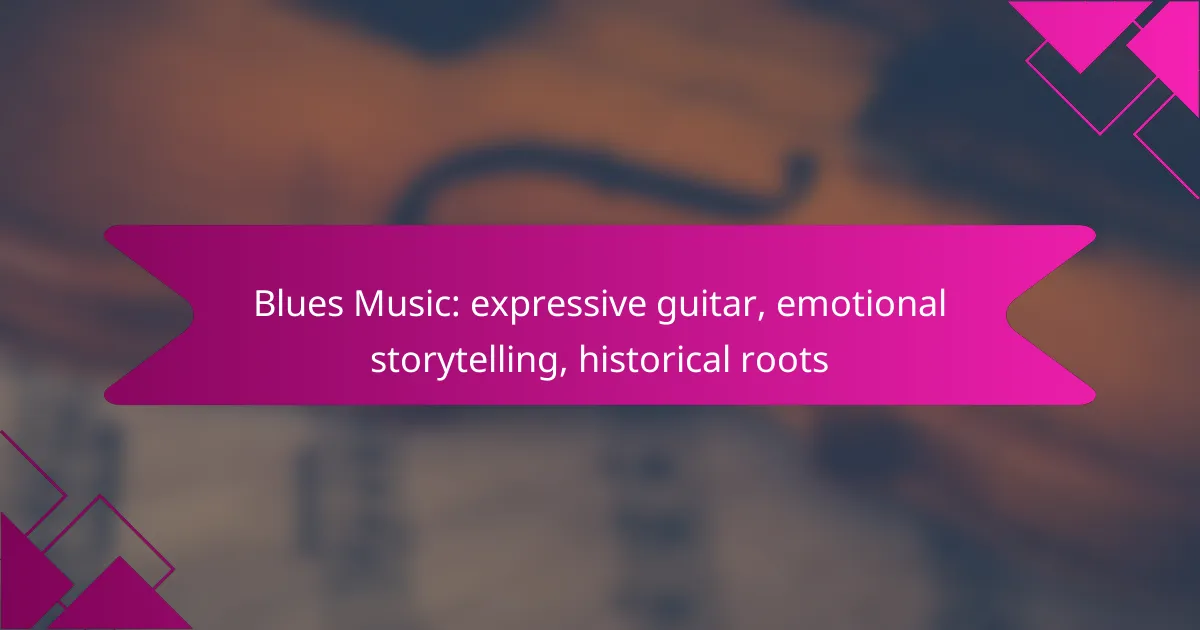Blues music is a powerful genre that combines expressive guitar techniques with emotional storytelling, capturing the essence of the human experience. Rooted in a rich historical context, it delves into themes of heartbreak, resilience, and joy, creating a profound narrative tradition. Influential artists like Robert Johnson, B.B. King, and Muddy Waters have shaped its evolution, leaving a lasting impact on the music world.

How can you learn blues guitar techniques?
Learning blues guitar techniques involves a combination of structured lessons, practice, and exposure to the genre’s rich history. By utilizing online courses, video tutorials, and instructional books, you can develop the skills needed to express the emotional depth of blues music.
Online courses from TrueFire
TrueFire offers a variety of online courses specifically designed for blues guitarists at all skill levels. These courses often feature video lessons from experienced instructors, covering essential techniques such as bending notes, fingerpicking, and improvisation.
Consider enrolling in courses that focus on specific styles within the blues genre, such as Delta blues or Chicago blues. This targeted approach can help you master the nuances of each style and enhance your overall playing ability.
YouTube tutorials by JustinGuitar
JustinGuitar provides a wealth of free video tutorials that are particularly useful for beginners looking to learn blues guitar techniques. His lessons cover fundamental concepts like the 12-bar blues progression and essential scales.
To get the most out of these tutorials, practice along with the videos and take notes on key techniques. Regularly revisiting these lessons can solidify your understanding and improve your playing over time.
Instructional books like “Blues Guitar for Dummies”
Books like “Blues Guitar for Dummies” offer comprehensive guides that break down blues guitar techniques into manageable sections. These resources often include exercises, tips, and historical context to enrich your learning experience.
When using instructional books, set aside dedicated practice time to work through exercises systematically. This structured approach can help reinforce your skills and provide a solid foundation in blues guitar playing.

What are the emotional themes in blues music?
Blues music often explores deep emotional themes, reflecting the human experience through storytelling and expressive guitar work. Common themes include heartbreak, resilience in the face of struggles, and moments of joy, each contributing to the genre’s rich narrative tradition.
Heartbreak and loss
Heartbreak and loss are central themes in blues music, capturing the pain of lost love and missed opportunities. Songs often depict feelings of sorrow and longing, resonating with listeners who have experienced similar emotions.
For example, a typical blues song might recount the story of a lover leaving, using vivid imagery and emotional guitar riffs to convey the depth of the singer’s despair. This theme allows artists to connect with their audience on a personal level, making the music relatable and impactful.
Struggles and resilience
Struggles and resilience are prominent in blues, reflecting the challenges faced by individuals in their daily lives. Many songs highlight the fight against adversity, whether it be economic hardship, social injustice, or personal battles.
Artists often use their lyrics to tell stories of overcoming obstacles, emphasizing the strength found in vulnerability. This theme not only inspires listeners but also serves as a testament to the enduring spirit of those who face life’s difficulties.
Joy and celebration
Despite its often somber themes, blues music also celebrates joy and life’s victories. Songs may express happiness through dance, love, and communal experiences, showcasing the lighter side of the human experience.
For instance, a lively blues track might invite listeners to dance and celebrate good times, illustrating how joy can coexist with pain. This duality enriches the genre, making it a powerful medium for expressing the full spectrum of emotions.

Which artists are essential to blues music history?
Several artists have played pivotal roles in shaping the history of blues music, each contributing unique styles and storytelling techniques. Key figures include Robert Johnson, B.B. King, and Muddy Waters, whose influences resonate throughout the genre.
Robert Johnson
Robert Johnson is often regarded as one of the most influential blues musicians of all time. His unique guitar playing and haunting vocals helped define the Delta blues style, characterized by its emotional depth and intricate fingerpicking techniques.
Johnson’s songs, such as “Cross Road Blues” and “Hellhound on My Trail,” showcase his storytelling prowess, often reflecting themes of love, loss, and hardship. His life story, shrouded in myth, adds to his legendary status in blues history.
B.B. King
B.B. King, known as the “King of Blues,” brought a vibrant energy to the genre with his expressive guitar solos and smooth vocal style. His signature technique, known as “string bending,” allowed him to convey deep emotions through his music.
King’s hits like “The Thrill Is Gone” and “Every Day I Have the Blues” highlight his ability to blend traditional blues with elements of jazz and R&B. His influence extends beyond music; he became a cultural icon, advocating for blues and its roots in American history.
Muddy Waters
Muddy Waters is credited with bringing the Delta blues to a wider audience, particularly through his electrified sound. His transition from acoustic to electric guitar marked a significant evolution in blues music, paving the way for rock and roll.
With classics like “Hoochie Coochie Man” and “Mannish Boy,” Waters infused his music with powerful rhythms and a strong sense of identity. His contributions helped establish Chicago as a major hub for blues music, influencing countless artists across genres.

How has blues music influenced modern genres?
Blues music has significantly shaped various modern genres by introducing expressive guitar techniques, emotional storytelling, and distinct rhythmic patterns. Its influence can be seen across rock, jazz, and hip-hop, where artists draw on its rich heritage to create innovative sounds.
Impact on rock music
The impact of blues on rock music is profound, as many rock musicians have adopted the blues scale and chord progressions. Iconic bands like The Rolling Stones and Led Zeppelin have incorporated blues elements into their music, often using guitar riffs that echo classic blues songs.
Rock and blues share a common emotional depth, with themes of love, loss, and hardship resonating in both genres. This connection has led to a fusion of styles, resulting in subgenres like blues rock, which emphasizes powerful guitar solos and heartfelt lyrics.
Influence on jazz improvisation
Blues music has greatly influenced jazz improvisation, providing a foundation for many jazz musicians. The twelve-bar blues structure is a staple in jazz, allowing artists to explore improvisational techniques while maintaining a familiar framework.
Jazz musicians often incorporate blues scales and motifs into their solos, creating a rich tapestry of sound that reflects the emotional storytelling inherent in blues. This blending of genres has led to the development of styles such as jazz-blues, where the improvisational freedom of jazz meets the expressive qualities of blues.
Connection to hip-hop lyricism
The connection between blues and hip-hop lyricism lies in their shared focus on storytelling and personal experience. Many hip-hop artists draw inspiration from the themes of struggle and resilience found in blues music, using similar narrative techniques in their lyrics.
Sampling is a common practice in hip-hop, where producers often incorporate classic blues tracks into their beats. This not only pays homage to the genre but also introduces blues’ emotional depth into contemporary music, creating a bridge between past and present musical expressions.

What are the key characteristics of blues music?
Blues music is characterized by its expressive guitar work, emotional storytelling, and deep historical roots. It often conveys feelings of sorrow and resilience through its unique musical structures and lyrical themes.
12-bar blues structure
The 12-bar blues structure is a foundational element of blues music, consisting of a repeated chord progression that typically lasts for 12 measures. This format usually follows a I-IV-V chord pattern, allowing for improvisation and variation while maintaining a familiar framework.
Musicians often use this structure to create a sense of tension and release, making it ideal for both vocal and instrumental performances. For example, a common progression in the key of E would be E7 (I) for four bars, A7 (IV) for two bars, E7 (I) for two bars, and B7 (V) for one bar followed by A7 (IV) and E7 (I) to conclude.
Call-and-response patterns
Call-and-response patterns are another hallmark of blues music, where a vocal line (the call) is answered by an instrumental or vocal response. This interaction creates a dynamic dialogue that enhances the emotional impact of the music.
In practice, a singer might deliver a line expressing a feeling of heartache, and the guitar or harmonica would respond with a complementary riff. This technique not only enriches the storytelling aspect of blues but also engages the audience, inviting them to participate in the musical conversation.
